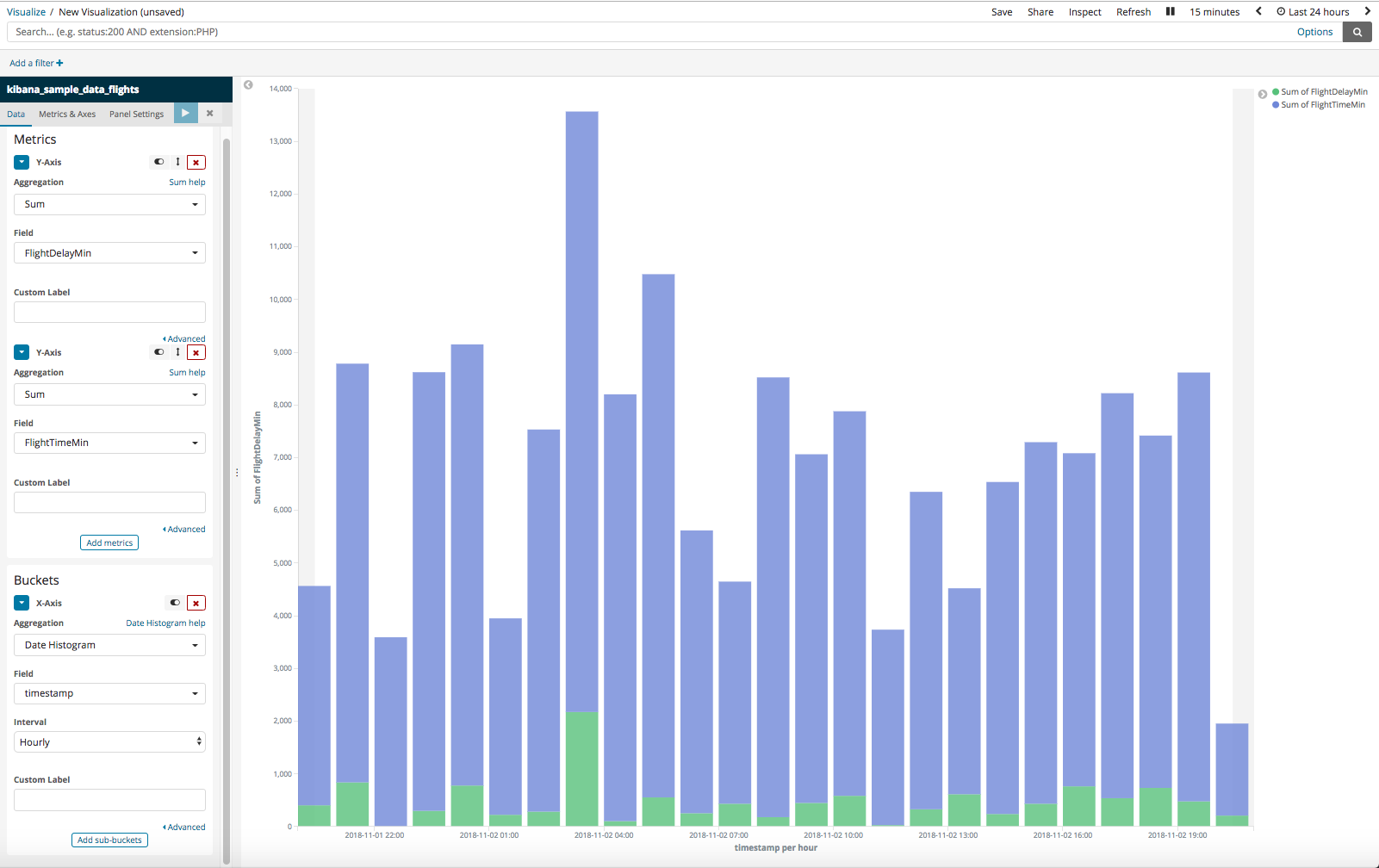You are going to need to use a Vega visualization to build this chart.
Try the following aggregation in Dev Tools. This will provide the percentage data needed to build the chart.
POST /kibana_sample_data_flights/_search
{
"size": 0,
"aggs" : {
"my_bucket_script" : {
"date_histogram" : {
"field" : "timestamp",
"interval" : "hour"
},
"aggs": {
"flight_time": {
"sum": {
"field": "FlightTimeMin"
}
},
"flight_delay": {
"sum": {
"field": "FlightDelayMin"
}
},
"total_time": {
"bucket_script": {
"buckets_path": {
"flightTime": "flight_time",
"flightDelay": "flight_delay"
},
"script": "params.flightTime + params.flightDelay"
}
},
"delay-percentage": {
"bucket_script": {
"buckets_path": {
"totalTime": "total_time",
"flightDelay": "flight_delay"
},
"script": "params.flightDelay / params.totalTime * 100"
}
},
"flight-percentage": {
"bucket_script": {
"buckets_path": {
"totalTime": "total_time",
"flightTime": "flight_time"
},
"script": "params.flightTime / params.totalTime * 100"
}
}
}
}
}
}
Then you can use this aggregation request in the vega visualization to build a chart. Below is an example that uses vega-lite to show the flight time perecentage.
{
$schema: https://vega.github.io/schema/vega-lite/v2.json
title: Chart title
// Define the data source
data: {
url: {
// Apply dashboard context filters when set
%context%: true
// Filter the time picker (upper right corner) with this field
%timefield%: timestamp
// Which index to search
index: kibana_sample_data_flights
// Aggregate data by the time field into time buckets, counting the number of documents in each bucket.
body: {
"size": 0,
"aggs" : {
"my_bucket_script" : {
"date_histogram" : {
"field" : "timestamp",
"interval" : "hour"
},
"aggs": {
"flight_time": {
"sum": {
"field": "FlightTimeMin"
}
},
"flight_delay": {
"sum": {
"field": "FlightDelayMin"
}
},
"total_time": {
"bucket_script": {
"buckets_path": {
"flightTime": "flight_time",
"flightDelay": "flight_delay"
},
"script": "params.flightTime + params.flightDelay"
}
},
"delay-percentage": {
"bucket_script": {
"buckets_path": {
"totalTime": "total_time",
"flightDelay": "flight_delay"
},
"script": "params.flightDelay / params.totalTime * 100"
}
},
"flight-percentage": {
"bucket_script": {
"buckets_path": {
"totalTime": "total_time",
"flightTime": "flight_time"
},
"script": "params.flightTime / params.totalTime * 100"
}
}
}
}
}
}
}
format: {property: "aggregations.my_bucket_script.buckets"}
}
// "mark" is the graphics element used to show our data. Other mark values are: area, bar, circle, line, point, rect, rule, square, text, and tick. See https://vega.github.io/vega-lite/docs/mark.html
mark: bar
// "encoding" tells the "mark" what data to use and in what way. See https://vega.github.io/vega-lite/docs/encoding.html
encoding: {
x: {
// The "key" value is the timestamp in milliseconds. Use it for X axis.
field: key
type: temporal
axis: {title: false} // Customize X axis format
}
y: {
// The "doc_count" is the count per bucket. Use it for Y axis.
field: flight-percentage.value
type: quantitative
axis: {title: "Document count"}
}
}
}
This will give you something that looks like
I think you will need to use regular vega (instead of vega-lite) to create the chart that you are really after. Here is a good example of creating a stacked bar chart in vega https://vega.github.io/vega/examples/stacked-bar-chart/. Try putting that example together with the data from the bucket script aggregation.


